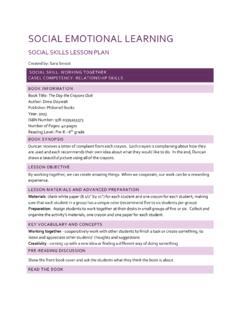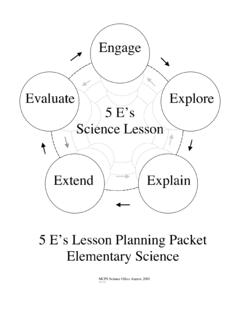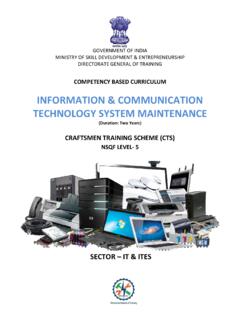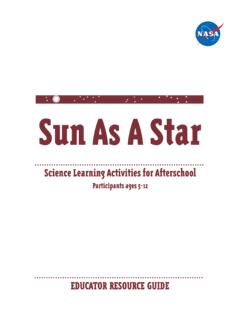Transcription of Creative Dance Integration Lesson Plans by Erika Cravath
1 1 Creative Dance Integration Lesson Plans by Erika Cravath23 AcknowledgmentsSupport for this project was provided by:I am sincerely grateful to the many people who assisted me in this project, including:Marilyn Berrett, my mentorDeAnn Sanders, my other mentorAll my students, who made this packet possibleClayton Cravath , my supportive husbandPartnershipBeverley Taylor SorensonArts Reaching & Teaching in Schools 2011 Erika CravathThis may be copied, distributed and posted for internet public access for personal, non-profit educational Commercial uses require the permission of the copyright curriculum standards were created by the Utah State Office of Education and are found at contact the author with questions or comments, email Cover art by Zachary WoffindenLayout by Heidi Israelsen45 Table of Contents Acknowledgments ..3 Introduction ..7 How to Use This Book ..9 Tips for Teaching Dance ..10 Other Ideas for Incorporating Dance into the Classroom.
2 122nd Grade Lesson PlansMath: 2-Digit Addition with Regrouping ..14 Math: Number Ordering ..16 Math: Telling Time ( vs. ) ..18 Social Studies: Cultures Part I ..20 Social Studies: Cultures Part II ..22 Social Studies: Mapping ..24 Music: Music and : Musical Canon ..28 Language Arts: Row, Row, Row Your Boat ..30 Languages Arts: Homophones ..32 Language Arts: Prefixes un- and re- ..34 Science: Animal Adaptation ..36 Science: Winter Weather ..385th Grade Lesson PlansLanguage Arts: Essay Composition ..40 Science: States of Matter ..42 Science: Static Electricity ..46 Visual Art: Illustration ..48 Social Studies: The Charleston and Dance Culture in the 1920 s and 30 s .50 Math: Fractions ..52 Language Arts: Reading Comprehension ..54 Music: Musical Beats and Rhythm ..5667 Introduction Most elementary school teachers would agree that they have too many demands and too little time. After spending half the day on literacy, then squeezing in math, science, and social studies, few minutes remain for arts instruction, recess, creativity, and community-building activi-ties.
3 However, a well-rounded education is vital for children, who must learn Creative and critical thinking skills. Children learn in many ways, yet schools often cater to visual and linguistic learners, and kinesthetic learners can be seen as trouble makers. Elementary school teachers are expected to provide a well-rounded, enriching education to all types of learners, ensuring that basic curricu-lum standards and life skills are taught. This book provides a detailed description of my method of addressing the above problem: using Dance to teach and supplement the required curriculum. Combining Dance with other cur-riculum areas is a student-centered approach that helps kinesthetic learners to better understand required class material. A fifth-grade student and kinesthetic learner said to me, Usually I don t understand science, but when you put movement into learning, I really understood all of it. Dance brings children a sense of novelty and anticipation.
4 A second-grade teacher I worked with said, My class literally cheers when they see Dance on the schedule. My students absolutely love to Dance . Through Dance , children can experience music and art from different cultures, pe-riods, and techniques, which promotes deeper understanding through experiential learning. Not only can Dance be used as a tool to teach curriculum, but also to teach creativity and critical thinking. Throughout the lessons in this book, students are given choices where they must decide how to solve a given Creative movement problem. Students learn to make independent decisions and to find confidence in their bodies. A fifth-grade student told me, I loved when we got to make up our own dances. I felt like a pro. Although it does require a willingness from the teacher to try a new and different method of teaching, Dance in the classroom has incredible ben-efits, and all you need is a little preparation and a lot of dancing bodies!
5 89 How to Use This Book This book is designed to give every elementary school teacher the tools he or she needs to begin incorporating Dance into every-day curriculum. On the next page, you will find teaching tips that are especially important when teaching Dance . The subsequent Lesson Plans in this book were specifically created for second and fifth grades, but could be adapted to fit younger or older grades as needed. The Lesson Plans in this book are divided into sections based on Lesson content: Reading, Math, Science, Social Studies, Music, and Visual Art. Each Lesson is divided into four sections: Experience/Identify, Explore/Investigate, Create/Perform, and Connect/Analyze. These are called the Four Universal Principles of Learning, and are the result of extensive research in the learning process by Marilyn Berrett. Use these Lesson Plans to incorporate Dance into your own classroom, and feel free to adapt them as needed. Following the Lesson Plans is a list of other topics and ideas to incorporate Dance into each curricular area.
6 Try to create your own dancing Lesson Plans using the Lesson Plans and ideas in this book as a guide. Two years ago, I worked with a fifth-grade teacher who was terrified of Dance and every-thing that related to Dance . She did not know how to start using Dance in the classroom. How-ever, after team teaching a few lessons with me, she was ready to teach Dance on her own. She later wrote, As a grade level we rotate and teach the other classes our science lessons. I have en-joyed incorporating some of the things Erika taught my class. It has helped me to become a better teacher. My goal for this book is to help you to become a more diverse, student-centered teacher, helping students of all learning styles to learn. For a digital copy of additional visual aids (specified for each Lesson if available), individual Lesson plan, or a copy of the entire book, please visit All materials can be found under the Resrouces tab in Activities and Tools, in addition to other arts integrated Lesson Plans in all four art for Teaching Dance Say when before what Describe when students will do something before describing what they will be doing.
7 For example, when the music starts, skip to a new place in the room and freeze in a curved shape. Other cues may include: when I say go, when I count to three, when your partner freezes, when I point to this picture, etc. Allow a little chaos As I have taught lessons where student creativity is central to the class, I have watched sev-eral teachers become worried that their students are incorrectly interpreting the Creative prompts. However, every student should have his or her own ideas to express during the Creative process. When twenty-five different ideas are being expressed, it can feel a little chaotic. The Creative pro-cess is not the same for everyone, so let there be a little chaos!Challenge students Elementary school students often surprise me with their dancing abilities. Just as in every subject, we must expect the best from students. Therefore, it is important to constantly challenge students to improve what they are doing.
8 Ask questions like: Can you make your Dance bigger? Can you show your movement more clearly? How can you make that movement more Creative ?Constantly add other elements of Dance Though a Dance Lesson may focus on creation of shapes, challenge students to use different body parts, energy qualities, levels, pathways, or timing. For example, shake your elbow while you skip. Now, turn your leap. Move in a curved pathway as quickly as you can. Perform the sequence as slowly as you can. Continue to add more layers on to an activity once they master its basic in the moment When teaching a Dance class, I sometimes forget to pay attention to what is going on around me because I am so focused on what activity is coming next. Instead, live in the moment with the students. Try to experience what they are experiencing and help them find new ways to explore and discover. As in all teaching, if you are aware of your students needs, you will be better able to teach with the students Whenever I move with the students, their commitment to the movement increases.
9 Instead of giving instruction then watching the students complete the task, participate with them. Move throughout the classroom instead of always standing in the front. Students often do not need a demonstration ; they just want the teacher to participate. Be clear and concise As I explain activities, sometimes I find myself taking too much time in explanation and an-swering several questions before the activity starts. Instead, explain the activity as simply as possi-ble. While students are moving, add on extra layers of difficulty or additional movement problems. Giving direction while the students are moving saves time and maintains student rules for Dance and remind students of them every time they come to Dance I have often found that when students come to a Dance class, they believe that all the rules of their classroom no longer apply. It is important to establish rules at the beginning of each class. Helpful rules can include: stay one foot away from all furniture and walls; when we Dance we speak with our bodies, not our mouths; when the music stops, you stop; do not run into each other; etc.
10 1213 Other Ideas for Incorporating Dance into the Classroom Literacy Make shapes based on prepositions Write a poem then create a Dance to perform as it is read Create a Dance based on the characteristics of a book character Recreate scenes from a novel or short story in a Dance Assign movements to each part of speech (noun, verb, adjective, etc.) and create movement sentences Write acrostic poems then use them to create a series of partner shapesMath Add and subtract movements from a Dance sequence Divide the class in half for a movement problem, then thirds, quarters, etc. Repeat patterns in movement sequences and have students identify them Create two- and three-dimensional shapes with the body Explain division of beats in music in terms of fractionsSocial Studies Learn to respect differences through watching peer-created dances and giving positive feedback Share dances from the students cultures Learn folk dances from countries around the world Practice group work through group movement problems and composition assignments Create a Dance inspired by an event in history ( major battle, political movement, exploration, etc.)









